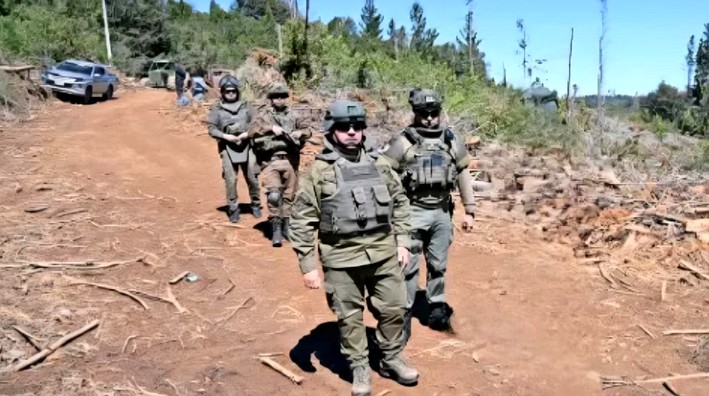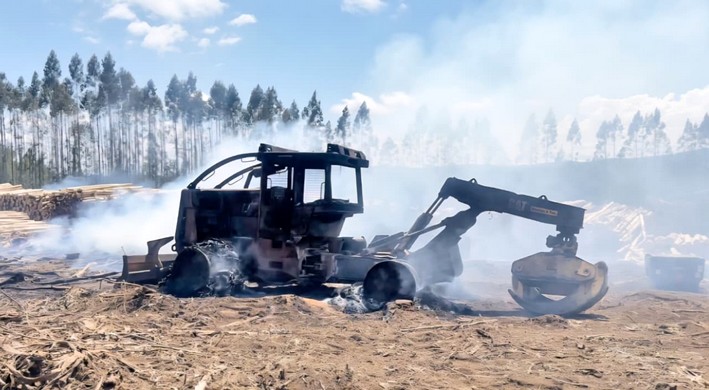Lessons from the Fire Season: The Need for New Legislation and Coordinated Institutional Framework
The numerous fire outbreaks recorded in the central region of the country since November—a period known as the fire season—not only affect trees and vegetation but also claim human and wildlife lives, leaving thousands displaced. These are just some of the devastating consequences of these events. What can be done to prevent such damage? How can we be better prepared? Below, transdisciplinary experts from the University of Chile share their reflections on the lessons learned.
Miguel Castillo, professor at the Forest Fire Laboratory of the Faculty of Forestry Sciences and Nature Conservation (FCFCN), argues that beyond emergencies, disasters, and damages, "we still owe the country a modern and coordinated institutional framework for forest fires. The weaknesses in regulations and legislation regarding forest fire laws have been laid bare." He adds, "This is just more evidence that for years, we've been patching up and addressing isolated issues when, fundamentally, we need to focus on the general behavior of the population toward forest fires, based on a proper prevention strategy and penalties when necessary."
The professor also highlights the need for policies and protocols regarding land use in municipalities lacking territorial planning that incorporates emergency criteria. Castillo emphasizes that water management is equally crucial—though not the sole solution for fires, it is a "vital asset" in combating them. "Responsible water use and civic behavior are essential to act generously and empathetically in emergencies. We must conduct a thorough review of infrastructure and emergency water sources, understanding that while water isn't always the solution, it is a territorial asset that undoubtedly helps contain fire spread," he explains.
Additionally, the expert notes that this intense fire season exposed a critical gap in Chilean legislation for addressing emergencies. "The legal framework is an extremely necessary issue that has been addressed partially and incompletely (...) We must push forward with the forest fire law, as work teams are now being convened—but only within an institutional table. This is something that’s coming, even beyond physical resources like planes and helicopters," details the University of Chile specialist.
Regarding emergency management, Professor Miguel Castillo stresses the importance of coordinated actions among authorities, firefighters, and volunteers because—in his view—forest fires are not the same as before. He highlights the need to "further strengthen first-response emergency mechanisms; coordination for extreme simultaneous events, which isn’t new compared to past seasons but was more severe this time. Additionally, better coordination is needed to minimize direct damages. This year, many animals and people died. That’s also a lesson about evacuation mechanisms, which fall into three categories: direct preventive evacuation, gradual evacuation, and last-minute evacuation—when the fire is nearly imminent, which is the least recommended as it carries higher risks, and escape routes are cut off by flames."
After the Flames Comes Reforestation
One key to recovering land devastated by forest fires is the reforestation policies led by the National Forestry Corporation (CONAF) in the south-central regions. Regarding this post-emergency phase, Álvaro Promis, an academic at the U. of Chile’s Faculty of Forestry Sciences and Nature Conservation, explains that given the disaster’s scale, it’s crucial to strive for "heterogeneous landscapes" rather than maintaining "homogeneous landscapes of massive radiata pine plantations" that currently cover vast areas nationwide.
"The question is how to achieve this when much of the land belongs to private owners. Here, the State’s role becomes fundamental by developing planning and zoning programs, aiming to create heterogeneous landscapes that combine forest plantations. It’s important to establish mixed forest plantations, agricultural lands, and promote the continuity and development of large native forest fragments," states Professor Promis.
The expert highlights two species: the Queule and the Pitao (or canelillo). Both are endemic to central Chile, and when affected by fires in small native forest fragments, they are left more vulnerable to regeneration and recovery. Regarding reforestation and soil and large-scale land recovery possibilities, the academic stresses the importance of following the Ministry of Environment’s Framework Law on Climate Change, which could be key to a new development model.
"From a climate change perspective, there’s a Framework Law on Climate Change by the Ministry of Environment. The State should promote afforestation and reforestation with native species and mixed crops. Thus, what CONAF should do is encourage mixed plantations with native species," says the academic. This, he adds, "should influence productive changes among small, medium, and large landowners. Perhaps the most important thing is to generate new economic value chains where landowners aren’t forced to sell their forest products to one or two large companies. Through a CORFO platform, a new industrial system should emerge, benefiting small and medium enterprises and producers with diverse species, so mixed species can also be part of a value structure."
The Other Victims of Forest Fires
Part of the impacts of these socio-natural disasters affect local fauna, particularly low-mobility animals (amphibians, reptiles, and small mammals) as well as birds that haven’t yet learned to fly. The flames claim the lives of wild and native fauna, wiping out degus, cururos, Rulo’s toadlets, lizards, and birds in their nests.
Small animals trapped by fires are the silent victims of forest fires, as their habitat, refuge, food, and community lie within those burned hectares, explains Dr. Valeria Rojas, professor at the Faculty of Veterinary and Animal Sciences (FAVET) of the University of Chile and director of the Center for Environmental Management and Biodiversity at the same academic unit.
The specialist emphasizes the need to advance in Disaster Risk Reduction (DRR). "The big lesson we still haven’t learned is the lack of coordination among different entities—academic, institutional, and civil society—to address fires, especially in post-disaster stages regarding low-mobility species," says Professor Rojas.
The center she has led since 2016 participates with Senapred in a risk management table for both wild and non-wild fauna. In the business sector, she notes, evacuation systems for livestock are also necessary—something currently lacking.
From Disaster Risk Management to Reduction
A novelty of the current fire season is that Chile now has Law 21364, which established the National Disaster Prevention and Response System, including a service (Senapred) that replaced the old National Emergency Office, adopting a more comprehensive approach to these phenomena.
As explained by Rosemarie Garay, an academic at FCFCN and member of the University of Chile’s Disaster Risk Reduction Program (CITRID), this shift in focus is crucial. "We’re now talking more about disaster risk reduction than management, which until now implied more emphasis on response than prevention," she says. The challenge, she warns, is implementing what’s outlined in the law: "coordinated and joint action among public and private entities involved in disaster risk cycles. The proposal is for ideally preventive actions to be decentralized, but that won’t happen quickly or easily."
Part of these challenges involves making Municipal Emergency Operations Committees more effective—which, as the specialist details, are "intersectoral and multidisciplinary groups of state technical representatives tasked with coordinating and managing local emergency responses. Their competence varies by region, province, and municipality, so preventive capacity-building is needed." Additionally, "resource allocation and oversight are critical—not just by the Comptroller’s Office but through technically sound supervision."
Another aspect is adapting territorial ordinances, including infrastructure for new scenarios. While Chile boasts robust seismic standards, Professor Garay notes that "there are no regulations for building in multi-threat territories, be it forest fires or otherwise (...) The same goes for other hazards. For years, we’ve discussed poor territorial planning—coastal buildings, hospitals, and nursing homes in unsuitable locations—yet minimal measures are taken, and the cycle repeats."
The same applies post-disaster. For instance, emergency housing standards have improved, but underlying issues remain unaddressed. "The core problem—holding perpetrators accountable and structurally resolving territorial planning—gets postponed. Analyzing Chile’s major disasters, it’s true that emergency response saves lives, and media coverage lasts days, but then we forget and move to the next episode without implementing efficient solutions: strengthening structures, improving access, or mitigation works. These are costly, and resources may never exist—but it’s not that we don’t know what needs to be done."
Source:www.radio.uchile.cl

















